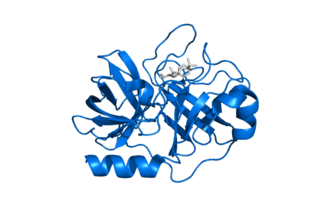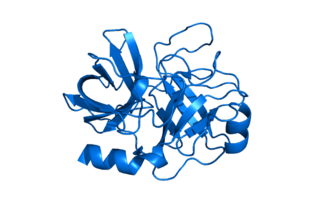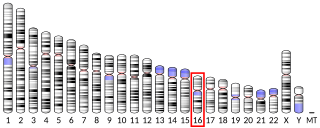Kallikreins are a subgroup of serine proteases, enzymes capable of cleaving peptide bonds in proteins. In humans, plasma kallikrein has no known paralogue, while tissue kallikrein-related peptidases (KLKs) encode a family of fifteen closely related serine proteases. These genes are localised to chromosome 19q13, forming the largest contiguous cluster of proteases within the human genome. Kallikreins are responsible for the coordination of various physiological functions including blood pressure, semen liquefaction and skin desquamation.

Kallikrein-1 is a protein that in humans is encoded by the KLK1 gene. KLK1 is a member of the peptidase S1 family.

Kallikrein-2 is a protein that in humans is encoded by the KLK2 gene, and is particularly associated with prostatic tissue.

Kallikrein-6 is a protein that in humans is encoded by the KLK6 gene.

Kallikrein-10 is a protein that in humans is encoded by the KLK10 gene.

Kallikrein-5, formerly known as stratum corneum tryptic enzyme (SCTE), is a serine protease expressed in the epidermis. In humans it is encoded by the KLK5 gene. This gene is one of the fifteen kallikrein subfamily members located in a cluster on chromosome 19. Its expression is up-regulated by estrogens and progestins. Alternative splicing results in multiple transcript variants encoding the same protein.

Serine protease HTRA1 is an enzyme that in humans is encoded by the HTRA1 gene. The HTRA1 protein is composed of four distinct protein domains. They are from amino-terminus to carboxyl-terminus an Insulin-like growth factor binding domain, a kazal domain, a trypsin-like peptidase domain and a PDZ domain.

Kallikrein-11 is a protein that in humans is encoded by the KLK11 gene.

Serpin B6 is a protein that in humans is encoded by the SERPINB6 gene.

Corneodesmosin is a protein that in humans is encoded by the CDSN gene.

Kallikrein-related peptidase 7 (KLK7) is a serine protease that in humans is encoded by the KLK7 gene. KLK7 was initially purified from the epidermis and characterised as stratum corneum chymotryptic enzyme (SCCE). It was later identified as the seventh member of the human kallikrein family, which includes fifteen homologous serine proteases located on chromosome 19 (19q13).

Kallikrein-13 is a protein that in humans is encoded by the KLK13 gene.

Kallikrein-8 is a protein that in humans is encoded by the KLK8 gene.

Kallikrein-14 is a protein that in humans is encoded by the KLK14 gene.

Prostasin is a protein that in humans is encoded by the PRSS8 gene.

Kallikrein-15 is a protein that in humans is encoded by the KLK15 gene.

Kallikrein-12 is a protein that in humans is encoded by the KLK12 gene.

Thymus-specific serine protease is an enzyme that in humans is encoded by the PRSS16 gene.

Kallikrein-related peptidase 9 also known as KLK9 is an enzyme which in humans is encoded by the KLK9 gene.

Brain-specific serine protease 4 (BSSP-4), also known as serine protease 22 or tryptase epsilon, is an enzyme that in humans is encoded by the PRSS22 gene.



















